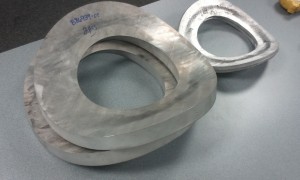Within industry, when one thinks about bending aluminum for process piping, one usually thinks of bending round tubing or pipe most often through rotary draw bending. A pipe or round tube is formed around a die which matches the outside diameter of the pipe and the desired radius. Pipe bends up to 180 degrees can be formed this way.
But aluminum process piping often involves pipe connections where one pipe intersects with another, and this intersection can require another type of aluminum bending. To make a connection of one pipe to another, there is a hole cut in one to allow the other to be inserted. The two pipes can then be welded together.
At times, however, a reinforcing curved aluminum plate is desireable to stiffen up the main pipe body where one pipe meets another. The reinforcing curved plate is called a “saddle”. The main pipe body hole is usually cut slightly larger than the intersecting pipe and the final location of the intersection is determined by where the saddle is welded onto the main body.
Circular reinforcement pads are made from waterjet cut aluminum circles that are then curved to match the main pipe body. Thicknesses range from 0.375″ to 1.31.” The curve can be formed on a plate roll or on a press brake with radius dies.

- ID of large cutout is 8.75″ (to go over the intersecting 8″ sch 40 pipe). Rolling Radius is 10″ (to saddle on to 20″ diameter main pipe body)
- ID of small cutout is 6.63″ (to go over the intersecting 6″ sch40 pipe). Rolling Radius is 7″ (to saddle on to 14″ diameter main pipe body)
These particular saddles will become part of the process piping for cryogenic tanks used in helium production.







